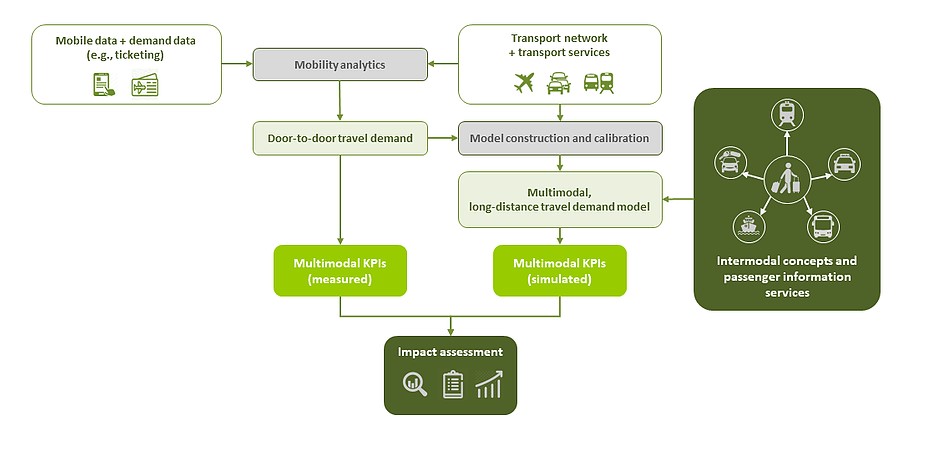
Information sharing is key to developing smart and seamless multimodal solutions for Europe’s citizens. That is the rationale behind TRANSIT, a recently launched SESAR 2020 exploratory project, led by Rubén Alcolea from Nommon Solutions and Technologies. In this interview, he outlines the core objectives and expected outcomes of the project, and how the COVID crisis is shaping the focus of its work.
What is the rationale and main objectives of the project?
One of the goals of the European transport policy is to establish a system that offers high quality mobility services while using resources more efficiently. The goal of TRANSIT is to propose innovative intermodal transport solutions based on information sharing and coordinated decision-making between air transport and other transport modes, and develop a set of methods and tools allowing the assessment of these solutions. To this end, we will develop new intermodal key performance indicators (KPIs), new methods for the collection of travel behaviour data based on personal mobile devices, and new approaches for the modelling and simulation of long-distance travel behaviour. All these new methods and tools will be tested through two case studies addressing the connection of air transport with the ground transport system in the Madrid and Paris metropolitan areas.
Why is it important to think about air transport in a multimodal/intermodal context?
So far, the possibility of exploiting air transport information to improve coordination with other transport modes, as well as how to take into account information from other modes in air transport decision-making processes, have received relatively little attention. We believe that solutions based on information sharing and common situational awareness across transport modes entail significant untapped potential for improving the quality, efficiency and resilience of the passenger’s door-to-door journey, for example by enabling more effective solutions for disruption management.
Is COVID impacting the rationale/ planned work of the project?
Definitely. First, the new intermodal solutions proposed in TRANSIT will have to take into account the new scenarios and/or regulations that may put in place in the near future as a result of the COVID-19 situation. Second, the COVID-19 crisis is likely to bring changes in travel behaviour that the data and models developed by TRANSIT may help to understand.
How are you using data/AI in your project? What type of data is needed?
TRANSIT will use a variety of new data sources, such as anonymised mobile phone records and data from public transport smart payment systems, to allow a detailed reconstruction of the different stages of long-distance multimodal trips and the measurement of new multimodal KPIs. To achieve this goal, we plan to develop a set of new methodologies and algorithms involving the combination of data fusion, statistical analysis and machine learning techniques. In a second stage, the information extracted from these sources will be used to develop high-detail agent-based models of long-distance travel behaviour in Spain and France that will be used to simulate and evaluate the solutions proposed by the project.
What is the purpose of the KPIs that you are developing?
The purpose of the KPIs is to evaluate the impact of the newly proposed transport solutions on the passenger journey, capturing the interdependencies between the different legs of the door-to-door trip. This will allow us to address questions such as whether air transport delays are mitigated or amplified by the connection with short-distance modes, how to render the full door-to-door journey more resilient to disruption, or how to facilitate more efficient and environmentally-friendly modal choices.
How could they be used in solutions targeting passengers? Could it be commercialised?
The KPIs could help understand the option that best suits passenger needs/preferences when planning their journey (e.g., they may look for a balance between travel time, travel time reliability and environmental impact), which can in turn open the door for new solutions that help passengers to re-adapt their itinerary on-the-fly, depending on the circumstances and the situation of the different transport networks.
What benefits do you hope your project will bring?
First, coordinated planning and collaborative decision-making across transport modes will increase the efficiency and resilience of the transport system as a whole, by reducing door-to-door travel times, reducing the impact of disruptions and enabling more efficient modal choices. At the same time, enhanced intermodal solutions are expected to lead to a much needed increase of the quality of the passenger experience for air travellers.
The JU is funding several projects on multimodality. How does your work compare to the others?
In relation to the other intermodal projects we coordinate, IMHOTEP, TRANSIT has a more strategic focus, looking at the long-term impact of intermodal solutions on the transport system as whole, while IMHOTEP addresses the development of short-term predictive models and decision support tools based on data sharing between different transport modes. The SESAR JU has put in place mechanisms to ensure that projects have an overview of their respective work in order to identify synergies and potential areas of collaboration.

This project has received funding from the SESAR Joint Undertaking under grant agreement No 893209 within the framework of the European Union’s Horizon 2020 research and innovation programme.
The project consortium is comprised the following organbistion: Nommon Solutions and Technologies (Coordinator); L'École nationale de l'aviation civile; Eidgenössische; echnische Hochschule Zürich; AENA S.M.E. SA and EUROCONTROL.
